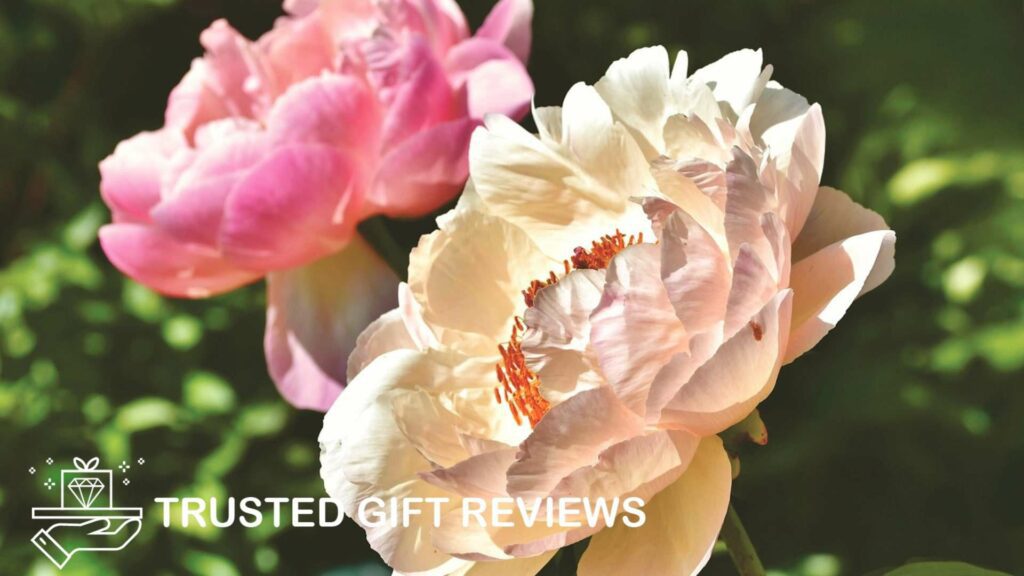If you’re looking for the perfect gift for November babies, we highly recommend their birth flowers. Not only are they beautiful, but they also show how much thought you put into the gift!
In this guide, learn more about these flowers, their meanings, and even their cultural significance.
What are the official birth flowers for November?


The official birth flowers of November are chrysanthemums and peonies. Both of which are known for their grand and full appearance and their wide range of symbolisms.
Chrysanthemums can symbolize your devotion to your lover, but they may also symbolize the pain of losing a loved one.
Peonies, on the other hand, can represent someone’s nobility and honor, but they can also symbolize one’s bashfulness.
Everything You Need To Know About Chrysanthemums


Chrysanthemums are a genus of flowering plants in the Asteraceae family. Depending on the species and variety, they can be annuals or perennials, but most are considered herbaceous perennials.
There are about 40 species in the genus, including the popular Chrysanthemum indicum, Chrysanthemum morifolium, Chrysanthemum zawadskii, and Chrysanthemum weyrichii.
What do chrysanthemums look like?


Most chrysanthemums typically have multiple layers of ray florets, creating a pom-pom-like appearance. These florets are small individual flowers that form part of a larger flowerhead.
While most are semi or double-blooms, some varieties, like Chrysanthemum morifolium, have single-blooms and a more daisy-like appearance.
They come in a wide variety of colors, including white, yellow, red, pink, and purple. You may also encounter some varieties that have bi-colored or multicolored petals, creating stunning and contrasting aesthetics.
What is the origin of chrysanthemums?


Chrysanthemums have a long and fascinating history that dates back to the 15th century BC. Their origin can be traced to East Asia, specifically to China, where they were first cultivated as medicinal herbs.
The popularity of chrysanthemums eventually spread to Japan and Korea. Various species were grown during their cultivation in Japan, and a wide variety of flower shapes were created.
The introduction of chrysanthemums to Europe occurred in the 17th century when Pierre Louis Blancard, a French merchant, brought three species of flowers he got from China to Marseilles.
From Europe, the cultivation and popularity of chrysanthemums spread to other parts of the world, including North America.
Today, chrysanthemums are grown all over the world and have become one of the most well-known and famous flowers worldwide.
What are the meanings and symbolism of chrysanthemums?


Chrysanthemums can mean different things depending on the culture of the recipient or the color of its florets.
They can mean deep love, happiness, respect, longevity, and loyalty in countries like Great Britain and death and mourning in African countries.
What do the colors of chrysanthemums mean?


What are the cultural associations of chrysanthemums?


What did the chrysanthemums symbolize in different periods in history?
What are the cultural associations of chrysanthemums?
What are the religious associations of chrysanthemums?


In Buddhism, it’s believed that chrysanthemums have powerful Yang energy. As such, they’re often used as offerings to the Buddha or as decorations in temples and altars.
Everything You Need To Know About Peony Flowers


Peony flowers or Paeonia is a genus of flowering plants that belong to the family Paeoniaceae. There are currently 33 known species, but some scientists argue that there are more.
There are various species and hybrids of peonies, but they can generally be classified into three main types: herbaceous, tree, and Itoh or intersectional.
Herbaceous have soft, non-woody stems, while tree peonies have deciduous shrubs with woody stems. Itoh or intersectional, on the other hand, are special hybrid crosses of herbaceous and tree peonies.
What do peony flowers look like?


Peony flowers are generally bowl-shaped or flat, with layers of petals that give them a grand appearance. Their petals are broad and rounded and come in a variety of colors, including white, pink, red, and yellow.
Some have a single or semi-double row of petals, while others can have multiple layers, forming a luxurious and dense flower head.
Depending on the variety, peony blooms can range from 2-12 inches in diameter. The actual plants range from compact herbaceous plants that grow up to 2-3 feet in height to larger tree-like plants that can reach up to 4-5 feet in height.
What is the origin of peonies?


Peonies originated from China and have been cultivated for over 2,000 years. The Chinese began cultivating peonies in 600 CE during the Sui and Tang dynasties.
Initially, peonies were grown as medicinal plants, as they were believed to have antioxidant and anti-inflammatory properties. Later on, they were used as food flavoring and garden decorations.
Peonies were introduced to Japan by China in the 6th to 7th century. The Japanese admired the beauty and symbolism of the peony, and it quickly became an esteemed flower in Japanese culture.
After Japan, they were brought to Europe in the 1800s by explorers who were exploring Asia. The European aristocracy fell in love with their beauty, and they soon became a sought-after ornamental plant.
Today, peony flowers can be seen in almost all countries. Numerous peony cultivars have been developed due to their popularity, resulting in a diverse range of flower forms, colors, and sizes.
What are the meanings and symbolisms of peonies?


Peonies have rich meanings across different cultures. They symbolize prosperity, honor, respect, romance, healing, bashfulness, good luck, and protection.
What do the colors of peonies mean?


What are the cultural associations of peonies?






